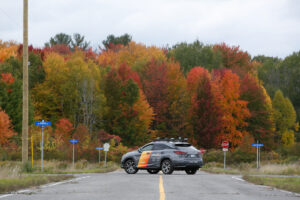The automotive industry is in continuous discussion about smart mobility solutions, autonomous driving cars, and robotaxis. Yet there is one essential voice that we less frequently hear from, and that is the cities that will host, enable, and empower the smart car.
What are smart cities doing to prepare themselves for this revolution of personal and commercial transportation? What sorts of issues do they face with the adoption of smart mobility technology? How are smart cities paving the way for the smart car and innovating to bring it to fruition?
To get answers to these challenging questions, we talked to two experts who are leading the charge for their individual cities, Tim Slusser (Detroit, Michigan) and Omar Choudhry (Ottawa, Ontario). Tim Slusser serves as the Chief of Mobility Innovation, leading the City of Detroit’s Office of Mobility Innovation (OMI), and Omar Choudhry is the Project Lead for the City of Ottawa’s Transportation System Management. We spoke to Tim and Omar about these issues to hear about the innovative ways they’re rising to the challenge and enabling the city and transportation of tomorrow.
Why would a city get involved in smart car technology?
Connected and autonomous vehicles (CAVs) are in a rapidly evolving and unsettled space that intersects multiple levels of government policies and involves hundreds of technology players. Should the city jump into such a dynamic complex landscape?

As Omar explains, for some types of technology deployments, it is better to wait until the dust settles. When it comes to V2I technology, if you have 1200 signals in the city and you need to outfit each with $50K of sensors and servers, this can quickly get out of the range of even the biggest city budgets. There is also the chicken and egg problem with V2X; either the cities or the automakers need to pay for a technology that isn’t useful until it becomes ubiquitous. Someone carries the burden, and it can be tough for cities to justify the business case of being early to “seed the network.” Additionally, there is the consideration that V2I is an “extra.”
Having a V2I system helps an autonomous car be safer, but the car must still operate safely even when there is no V2I infrastructure in place. Things like housing, homelessness, and other more pressing concerns tend to loom larger for city planners in weighing public need.

Tim concurs that sometimes technology deployments can be a wait and see situation. However, he adds that nearly every form of mobility solution needs support from cities in some form. That means that the city needs an informed opinion about the impact of future technology and mere awareness of industry trends isn’t enough.
Both Omar and Tim agree that the way to move forward is for a city to get involved in things like running trials. By being proactive and understanding the technology, the city can build for the long term. It can influence not just the roads, but the structure, the housing, and the services that people depend on. And it can understand the uniquely local circumstances each city brings to bear.

Forward-looking cities clearly see the value in staying actively involved. Tim considers Detroit, being the Motor City, is in a unique position with transportation in its DNA.
Detroit mayor Mike Duggan founded the Detroit Office of Mobility Innovation (OMI), and Tim’s job at the head of this office is completely focused on the challenge of understanding and integrating future mobility solutions rather than dealing with day-to-day issues like traffic or parking as many of his city peers.
Omar feels similarly that Ottawa has a unique perspective due to the city’s entrepreneurial background and mindset. He explains that startup mindset has a very “get ‘er done” attitude, and it’s one that extends to his office. His team does R&D when needed, pitching in to help companies with moving proof-of-concepts to real-world implementations.
What is the right mix between private and public ownership for municipal mobility solutions?
In areas where technology is moving fast, it makes sense for municipalities that move more slowly to work with private companies rather than go it alone. But this needs to be approached carefully. Tim says privatization plays a significant role in the future of Detroit, especially when it comes to parking and electrification infrastructure.
Indeed, Detroit has decided to deploy 300 charging stations on city property to ensure that there will be enough capacity to move people, goods, and services when electric vehicles become predominant. To do this, they are working closely with private parties such as e-vehicle charging companies and parking solution providers. By acting as both a coach and a landlord for these services, the city gets a chance to both help steer the technology as well as collect revenue. The companies benefit too.
Not only do they get a chance to vet their technologies but, by working closely with the city, they also understand more intimately what cities require in their solutions. Tim knows that the knowledge and interaction he has with these private companies helps them refine their tech and get a faster return on investment dollars.
Omar adds that it’s essential for cities to control their own destiny. With public-private partnerships, the city gets something sooner than they would otherwise, the public gets access to a new system or technology, and the private firm gets access to a valuable asset. However, these efforts don’t work out 100 percent of the time. There are risks of failure when it comes to working with new technology and earlier stage companies, so managing that risk and not putting all your eggs in one basket is important. But it also is incumbent on those involved to ensure that the business case for the long-term value of an asset or initiative is properly explained when budgetary decisions or restrictions inevitably come.
How does a city manage competing goals such as providing for personal mobility needs versus providing public services or pedestrian-friendly urban environments?

On this continent, personal car ownership has always been strongly associated with independence, and people don’t want to give up their cars easily. Yet, cities with urban cores full of a walkable mix of residences, businesses, restaurants, and green space have been shown to be areas that people prefer over multi-lane roads and blacktop-covered acres of parking.
Omar and Tim both acknowledge that this dichotomy can be a struggle, and it’s a struggle that’s different for every city depending on their existing buildings, roads, budgets, and culture.
That said, cities are planning for urban density and pedestrian and cyclist pathways when possible, and Ottawa is no exception. But as Omar says, VC firms can easily justify funding mobility solutions like scooters for the potential of a return on investment, but don’t typically have a mechanism to fund greener spaces in cities that need parking lots torn up and trees planted, except perhaps through social impact investment.
Cities providing incremental livability improvements for its residents don’t offer a return on investment, so these projects must be funded wholly by the city or through incentives to developers. Tim agrees that VC money flows more easily into projects like robotaxis, even when companies aren’t showing a return.
In a bid for better sustainability, Tim is trying to reduce the number of vehicles on Detroit streets. As an example, the city is attempting to get parking structures and lots designed to also host multimodal options like bicycles and scooters. He says it’s important to recognize that not everyone has a car – not just in a utopian “free transportation” future, but now – and offering solutions that cover the wide range of mobility options is critical. While he acknowledges that cars get a large portion of mindshare, it’s a mistake to design cities only for cars – they need to be designed for people first. Tim points to an autonomous pilot program the city is running to address the needs for elderly and disabled individuals. As he explains it, this is a case where the technology is truly needed by the people it serves, unlike most use cases for autonomous.
Because of the needs of the individuals, they have someone for personal assistance who can also act as a safety driver while they work out the bugs. Tim says this exemplifies the type of activities the city is doing to gain experience while being useful in the short-term, letting his OMI build a sustainable city for its citizens over the longer term.
As both Omar and Tim point out, the long-term detriment to car-centric designs is that they tend to push people out to the suburbs, eventually hollowing out the city, and this declining livability becomes a self-reinforcing issue. Thus, it’s in everyone’s best interest to try to manage travel capability and demand through multiple mechanisms, viewpoints, and stakeholders.
How does a city cooperate with multiple layers of government, like county, state/province, or federal?

Tim says that they want Detroit to be a model city and, because they have tough challenges (such as poor air quality or racial and wealth inequities), they are in an ideal position to find fixes. As Tim states: “If we can fix it in Detroit, you can fix it anywhere.” To do this, the city has built strong partnerships with the state as well as with politicians at multiple levels, offering various touchpoints for collaboration and information sharing. He also works with other Michigan cities like Ann Arbor and Grand Rapids, sharing Detroit’s experiences and learning how other cities are dealing with issues.
Omar too believes that strong collaboration is necessary with other government levels, and it comes down to getting involved in lots of different projects. He points out that the province and federal governments have a much greater ability to raise money and invest than the city does. As an example, he mentions that Area X.O has received funding from all three levels of government (municipal, provincial, and federal) because all three layers find value (albeit in different ways) in the capability Area X.O offers and the ecosystem they are building.
Both Tim and Omar believe that cooperation and open sharing are critical, not just for cities to be successful, but for mobility technologies to survive as they work their way to the market. As Tim puts it, as much as they want to compete against other cities and bring businesses to Detroit, they recognize that this only builds out an offering in a single city.
That’s not a recipe for success; the long-term plan for any company requires wide adoption and a consistent marketplace. So, Detroit is eager to share their knowledge with other cities so that they don’t have to repeat projects to relearn the same lessons. Indeed, their international openness helps everyone.